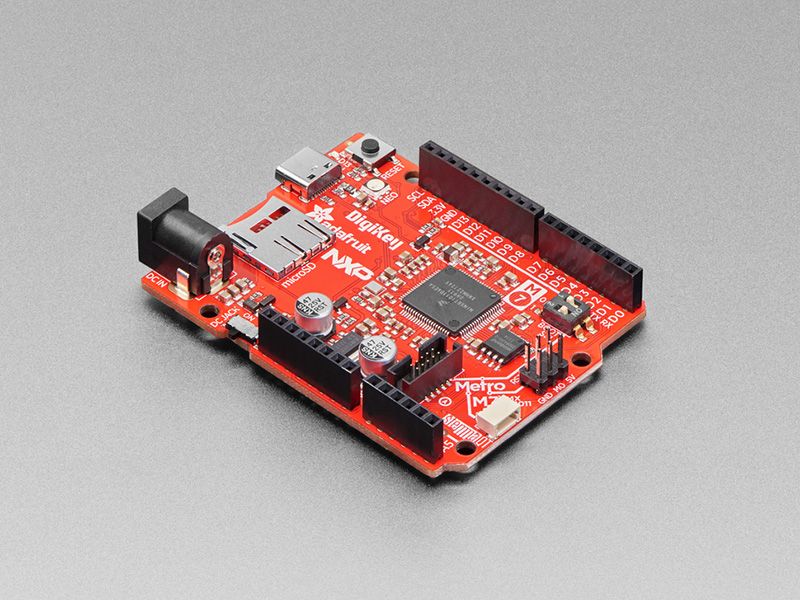
Metro M7 with microSD by Adafruit
Your favorite electronics companies have collaborated to make the fastest Metro ever! For this new product, DigiKey, NXP and Adafruit all contributed the stuff they know best: shipping parts fast (DigiKey), designing microcontrollers (NXP) and crafting great products with tutorials (that’s us, Adafruit!)
We teamed up to present to you the Adafruit Metro M7 with microSD! An NXP iMX RT1011 microcontroller powers this board with a 500 MHz ARM Cortex M7 processor. There’s 8 MB of execute-in-place QSPI for firmware + disk storage and 128KB of SRAM in-chip. Arduino-compatible headers make using any ‘shield’ daughterboard easy. And, as you can expect, there’s a micro SD card slot wired up right on board so that you can read files or data log easily to removable, wear-leveled storage.
The iMX series of chips is the fastest microcontrollers around, with a Cortex M7 processor that is more powerful than the M0 or M4, and clock speeds of 500MHz+. For pure performance, there’s nothing better! This chip family is well known for being featured in the Teensy 4 dev board series. Now we have a Metro-shaped board so you can use many Arduino shields, that is fully open source so you can adapt the design to create your own custom layouts, and a USB drag-n-drop bootloader plus CircuitPython support for easy development. Beginners and experts alike will enjoy the combination of low cost, roomy memory and storage, and no-soldering quick start.
Please note that this board does not have Arduino or Platform.io support. You can program it with CircuitPython, a fast-to-start embedded version of the popular Python programming language, or with MCU Xpresso IDE for C/C++ advanced embedded development.
Features:
- NXP iMX RT1011 processor - ARM Cortex M7 processor running at 500 MHz, with 128KB SRAM and high-speed USB!
- Micro SD Card Slot - For audio files, images, scripts, or data logging. Uses SPI port and a chip select pin
- 8MB of QSPI XIP Flash
- Power options - 6-12VDC barrel jack or USB type C
- Arduino-UNO-shape so shields can plug in
- Reset button - Click to restart, double-click to enter UF2 bootloader
- Boot-mode switches to get into the ROM bootloader (you can always reload code over USB if TinyUF2 gets corrupted somehow)
- SWD connector for advanced debugging access.
- On/Off switch
- STEMMA QT connector for I2C devices
- On/User LEDs + status NeoPixel
- Works with CircuitPython!
Purchase
Contribute
Have some info to add for this board? Edit the source for this page here.
CircuitPython 10.0.3
This is the latest stable release of CircuitPython that will work with the Metro M7 with microSD. Use this release if you are new to CircuitPython.
Modules included in this download
_asyncio _bleio _bleio (HCI co-processor) _pixelmap adafruit_bus_device adafruit_pixelbuf aesio analogio array atexit audiobusio audiocore audiomixer audiomp3 audiopwmio binascii bitbangio bitmapfilter bitmaptools board builtins builtins.pow3 busdisplay busio busio.SPI busio.UART codeop collections digitalio displayio epaperdisplay errno fontio fourwire framebufferio getpass gifio i2cdisplaybus io jpegio json keypad keypad.KeyMatrix keypad.Keys keypad.ShiftRegisterKeys keypad_demux keypad_demux.DemuxKeyMatrix locale lvfontio math microcontroller msgpack neopixel_write onewireio os os.getenv pwmio rainbowio random re rotaryio rtc sdcardio select sharpdisplay storage struct supervisor synthio sys terminalio tilepalettemapper time touchio traceback ulab usb_cdc usb_hid usb_midi vectorio warnings zlibFeatures: STEMMA QT/QWIIC, USB-C, Arduino Shield Compatible
CircuitPython 10.1.0-beta.1
This is the latest development release of CircuitPython that will work with the Metro M7 with microSD.
Alpha development releases are early releases. They are unfinished, are likely to have bugs, and the features they provide may change. Beta releases may have some bugs and unfinished features, but should be suitable for many uses. A Release Candidate (rc) release is considered done and will become the next stable release, assuming no further issues are found.
Please try alpha, beta, and rc releases if you are able. Your testing is invaluable: it helps us uncover and find issues quickly.
Release Notes for 10.1.0-beta.1
Modules included in this download
_asyncio _bleio _bleio (HCI co-processor) _pixelmap adafruit_bus_device adafruit_pixelbuf aesio analogio array atexit audiobusio audiocore audiomixer audiomp3 audiopwmio binascii bitbangio bitmapfilter bitmaptools board builtins builtins.pow3 busdisplay busio busio.SPI busio.UART codeop collections digitalio displayio epaperdisplay errno fontio fourwire framebufferio getpass gifio i2cdisplaybus io jpegio json keypad keypad.KeyMatrix keypad.Keys keypad.ShiftRegisterKeys keypad_demux keypad_demux.DemuxKeyMatrix locale lvfontio math microcontroller msgpack neopixel_write onewireio os os.getenv pwmio rainbowio random re rotaryio rtc sdcardio select sharpdisplay storage struct supervisor synthio sys terminalio tilepalettemapper time touchio traceback ulab usb_cdc usb_hid usb_midi vectorio warnings zlibFeatures: STEMMA QT/QWIIC, USB-C, Arduino Shield Compatible
Absolute Newest
Every time we commit new code to CircuitPython we automatically build binaries for each board and language. The binaries are stored on Amazon S3, organized by board, and then by language. These releases are even newer than the development release listed above. Try them if you want the absolute latest and are feeling daring or want to see if a problem has been fixed.
Previous Versions of CircuitPython
All previous releases of CircuitPython are available for download from Amazon S3 through the button below. For very old releases, look in the OLD/ folder for each board. Release notes for each release are available at GitHub button below.
Older releases are useful for testing if you something appears to be broken in a newer release but used to work, or if you have older code that depends on features only available in an older release. Otherwise we recommend using the latest stable release.
